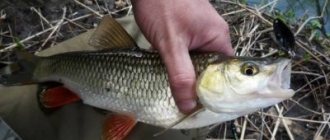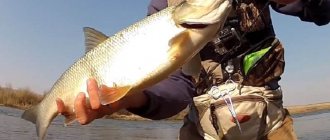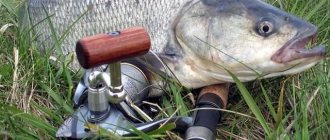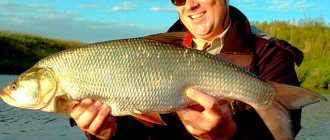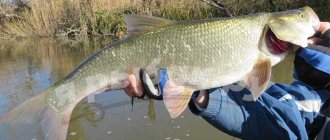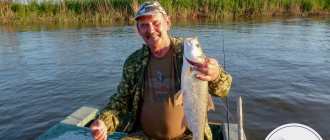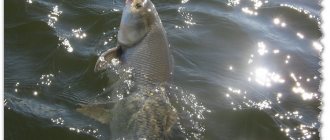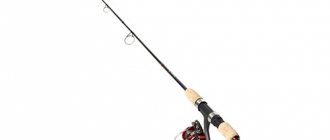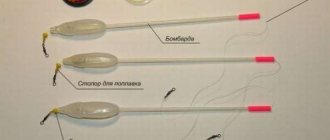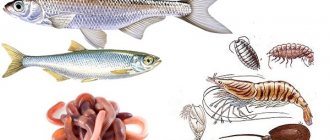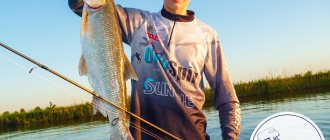- Fishing
3654
The method of fishing with bombarda (or, as it is also called, sbirulino) was invented by the sports team “Team Daiwa” back in the last century. The simplicity and elegance of the equipment with a large bombard float allows you to successfully fish on 5 continents. The growing popularity of bombard fishing is associated with the opportunity to take advantage of two types of fishing - spinning and fly fishing. You can catch almost any fish with a bombard, but this tackle is especially effective when hunting fish that live in the upper layers of water. Recently, more and more anglers have been found on rivers using sbirulino when catching asp.
For catching asp on a spinning rod
You can quickly catch an asp immediately after spawning or during the full moon phase. At this time, he actively feeds and takes most of the bait. They are caught both during the day and at night, during the warm season from spring to autumn, with the exception of the spawning period. The water level at the fishing spot plays an important role, especially when the fish is on the hook and its chaotic race has begun.
Did you know? Due to the special way of hunting, the asp is also called “horse” or “grab”. Jumping out of the water, it falls on top of the victim, making a loud bang as it hits the water, which puts smaller fish into a stupor.
It should either be constant or gradually increase. The predator prefers not to swim in shallow water and bites there very rarely. Guard him in the shallows, near aquatic plants, in places where the current accelerates. Asp is a schooling fish, and if you catch one, there are always a couple of others nearby. The aggression and tenacity of the caught fish force anglers to use durable equipment that can withstand the speed and pressure.
Of course, for this you will need a spinning rod with standard equipment:
- rod;
- reel with fishing line;
- hooks;
- spoon.
Characteristics of the main elements:
| Name of gear | Peculiarities |
| Rod | parabolic system; length - 3 m; test range - 20–40 g; material of manufacture - metal, carbon; large diameter guide rings; strong reel seat. The predator attacks a moving bait, attacks and continues moving. Therefore, you need to worry about the strength of the gear and fastening. |
| Coil | high-speed, inertia-free; size - 3000–4000. |
| fishing line | monofilament; cross-section diameter - 0.15–0.18 mm; footage - from 100 m to 120 m. The color of the fishing line may vary depending on the weather and water conditions. Golden is suitable for bright sunny days when it reflects the sun's rays. It will also be good for muddy ponds. Silver or blue-silver is suitable for a cloudy day. In a clean reservoir it is worth using a transparent fishing line, in a polluted and muddy one - brown. |
| Leashes | Not needed, because the predator does not have teeth or sharp fins that can cut the fishing line. |
| Hooks | At least 2 pieces, No. 7-8. The bait is placed on 2 hooks at once, otherwise the predator removes the bait and leaves. |
| Spoon | Kastmaster is the best long spinnerbait with a weighted top. Essentially, it is a cylinder with the top and bottom cut off at angles of 17° and 23°, respectively. The coating is galvanic. At the top there is a loop for attaching fishing line, and at the bottom there is a treble hook. The manufacturer of the original model is Acme. There are many replicas of this excellent catching spoon on the market, but how effective they are must be checked directly by fishing. |
Important! On a sunny day, a spinner is needed with a yellowish (golden) and copper tint, and on a cloudy day
—
with silver.
Tactics and fishing techniques
Depending on the time of year, the specific fishing location and fishing habits, you can choose one of several tackles - fly fishing, spinning rod, float rod. Regardless of which gear you prefer, you need to know the subtleties to increase the likelihood of successful fishing.
Fly fishing
Having arrived on shore, you need to develop a suitable plan of action. At the beginning of summer, the predator gathers in schools, driving the fry, and collective hunting is used, which shows the high level of intelligence of the fish. By finding a cauldron (a place where a school of asp drives the fry) and throwing gear there, you can count on a good catch. In such cases the bite follows immediately. If you can’t find the boiler, you need to cast the fly onto the rapids, and not into the active stream of the current, but to the border where the flow is not so rapid.
Many fishermen disagree on whether the asp takes the fly right away or waits until the current brings it under his nose. Try both options - let the bait move with the flow of water, without relaxing for a second - be prepared for a sharp hook.
Spinning
There are no preferences in choosing fishing line. Monofilament, braided - depends on habits. The optimal diameter is 0.2-0.3 mm. This fish does not have sharp teeth like pike perch or pike, and a metal leash is not needed. As bait for catching asp, it is advisable to have several baits on hand - the preferences of the predator change sharply and unexpectedly. A spoon that caught a great bite a week ago may turn out to be useless today.
The castmaster for asp is popular - due to its large weight, it can be thrown over a considerable distance. Bombarda, known as sbirulino, performed well. A large float pulls the bait, which in strong currents and shallow depths jumps over the rocks, like a fish looking for edible insects. The asp probably won't resist. Vladimir Struev talks interestingly about this bait in the video below.
Experienced fishermen do not forget proven spoons. A spoon weighing 30-45 g helps out in cases where other baits are useless. A small wolfer can also be a good choice.
You should approach fishing carefully. For example, when hunting for pike, fans of spinning rods try fishing through different layers of water. If the target is an asp, it makes sense to give preference to the upper and middle wires - he rarely hunts below. Therefore, after casting the bait, either start retrieving it immediately or after a second so that the spoon or castmaster does not have time to lie on the bottom.
Float rod
Asps are caught relatively rarely with this tackle, although there are such masters. They can be understood - cautious fish rarely bite the bait, but the process of catching even a kilogram specimen will bring a whole range of feelings. It is not advisable to use a fishing line thicker than 0.3 mm - this will scare away wary fish. But if a specimen weighing 5-7 kilograms is tempted by the bait, it will not be easy to pull it out.
The fishing rod should be long - at least 3.5 meters, and preferably more. There are no special requirements for it; it is better to take the most convenient one. Inertia-free will allow you to make long casts and eliminate the possibility of the line getting tangled. Finally, the float. It’s better to take a transparent one - it’s almost invisible, which means it won’t attract unnecessary attention. True, these are not always available for sale, so some craftsmen use homemade floats.
When casting, try not to get too close to the water; stay against the backdrop of bushes and not in open areas. A strong, brave, but cautious asp, having noticed the shadow or silhouette of a fisherman, may well go to another place. That is why it is better to choose a long fishing rod - you can cast bait without coming close to the coastline.
The asp always offers fierce resistance to the fisherman. A spinning player should always remember about his strength and intransigence, especially when configuring the tackle.
Spring asp is the best fish for hunting. Believe me, every fisherman dreams of catching such a fish, and not just a simple one, but a bigger one! And such a spinner as the castmaster will cope with this task perfectly. This is exactly the type of spinner that you can customize for yourself. If you wish, you can even make a spinner yourself, however, here it all depends on your personal abilities and dexterity of hands.
Tips for fisherman: Catching asp with a spinning rod - the best videos - What to choose for fishing
The main advantage of castmasters is excellent aerodynamics during flight. Even a novice spinning angler can cast this bait far. Metal models fly best: pipe sections, jigs, triangular baits. And the wiring needed is quite simple. Uniform, rapid winding of the reel leads to the capture of the first asps. And then you can master the “step”, catching during the falling phase of the bait or during a pause from the bottom.
There are several basic ways to wire a castmaster. Firstly, high-speed uniform winding gives a good result. And although seasoned spinners consider it primitive, it is quite prey. The castmaster's long casting and high speed fishing in a certain water horizon are all the secrets of this fishing.
To catch a trophy asp, experienced fishermen use a little trick. The castmaster is thrown into the intended location of the boiler in advance. The bait lies on the bottom until the asp hunt begins. This maneuver of the spinning rod misleads even the most cautious individuals.
So why not try it? Even if the fly catches only a small fish, the extra tails still won’t hurt, and the pleasure is worth it.
The simplest, and therefore probably the most common, combinations are those with a fly in front of the main bait. Here the chase effect is used in a visual form, where the “pursued” small fly can imitate both an insect and a fry (Fig. 1) . Therefore, not only predatory and semi-predatory fish are caught with this combination, but also purely peaceful ones - such as bleak, roach and bream.
Unlike the “spinner-spinner” duo, the combination with a fly has its own characteristics. The main difference is a pair of fundamentally different baits. Many anglers are confident that flies most accurately reproduce the real food of almost all fish. By the way, I think so myself. Therefore, if a large main bait (spoon or wobbler) is initially “programmed” for one or two specific predators, then, in principle, anyone can bite on the fly - from bleak to seasoned pike.
Again, a paradox: the “toothy” one often ignores large baits, but takes a small fly, which it doesn’t even feel the taste of. The asp, which just yesterday grabbed the castmaster almost in the air, today does not see it point-blank and is caught only with a wabik. And salmon in summer generally clearly prefers salmon flies to all spinners and wobblers. As you can see, a small addition to the gear can bring a very big result.
So why not try it? Even if the fly catches only a small fish, the extra tails still won’t hurt, and the pleasure is worth it.
Equipment for such combinations can be different: both standard and special (Fig. 2) .
It all depends on how realistic the pike bite is and for what exactly. For example, if we catch an asp on a castmaster or a salmon on a spinner, then the probability of a “toothy” bite is negligible, and metal leashes are clearly not needed. Therefore, here flies are usually attached either directly to the main fishing line (Fig. 2a) or on its loops (Fig. 2b) - after all, both the flies and the main bait are “targeted” at the same large fish.
If you are hunting for pike and perch, and only “striped” ones are taken on a small fly, then there is no need for a second metal leash. But if a large streamer is used as an additive, it is risky to catch without “metal”. Therefore, in such cases, I usually make a special double leader from leader material (Fig. 2d) , leaving a 10-15 cm long branch on the swivel knot for tying a specific fly or a small fastener.
I would like to especially note that the combination with a fly is the optimal equipment both for reconnaissance in unfamiliar places and for catching a wide variety of fish. Therefore, do not be lazy and prepare at least a couple of appropriate flies for your next fishing trip. And then there will be no fish left in the pond, which, in principle, will be able to avoid getting to know you.
To choose the right supplement, you need to consider several factors. If we want to catch anything that bites, a fly in the form of a nymph or larva would be optimal. For obvious predators, a streamer, including the largest ones, is better suited. However, it should be remembered that a volume fly, due to its braking effect, can negatively affect the main bait. Therefore, with a wobbler or jig, they usually put one small “short” fly or something similar, for example, a phosphorus spinner (Fig. 3) .
But a fairly heavy jig or spinner with a weight head will “pull out” almost any additive. Nevertheless, here too I recommend, first of all, to try the flies. After all, even peaceful fish will bite on a nymph or an imitation of a bloodworm, and seasoned predators may also be coveted by a large streamer. Moreover, here too, what is caught with the supplement often exceeds the catch with the main bait. Imagine, this could happen on your next fishing trip, and we don’t have the right flies!
True, a twister, octopus or foam fry can be no less effective in this case. If we remember that the twister is an active bait, the octopus is semi-active, and the foam rubber is passive, it becomes clear: the first is more likely to manifest itself when the predator is actively biting, the second - when the predator is actively biting, and the third - when the predator is weak.
In my personal practice, luck smiled more often on the next two “duets” (Fig. 4) .
Although, depending on the specific situation on the pond, any pair of baits may be optimal. True, the “ideal” will have to be selected experimentally, and for this you need to at least try several basic combinations. But is it necessary to prepare all of them at home or can you “compile” them while fishing? To answer this question, you need to remember about the equipment.
Since when bottom fishing the probability of a pike bite is especially high, both baits should have a metal leash: either a soft one made of leash material, or a semi-rigid one made of thin wire. Then, if you put fasteners on the ends of both leashes, you can quickly replace both the main and auxiliary baits.
Victor Andreev, “Original spinning baits”
Devon-turbines for asp also have all the necessary qualities for catching this white predator. Retrieving when fishing with Devon turbines is done quickly and evenly. The only disadvantage of this spoon is that it will only work with high-tech production and requires constant care.
Installation of float gear
The assembly of float gear or donkeys begins with securing the fishing line to the spool of the reel. A loop is made at its end. Then the main line is passed through the loop, twisted into a figure eight and folded. It turns out to be a double ring, and at the end of one of the rings there is a loop.
The resulting structure is put on the reel spool so that the line bends as it rotates, then the reel will rotate normally. This is necessary so that the line on the spool does not turn idle when the fisherman is pulling in the catch. The line is then wound onto a spool and a spinner is tied to the end.
For this:
- Take the tip 15–30 cm long and pass it through the loop for attaching the fishing line.
- Holding the lure in your left hand, wrap the end 4-6 times around a straight section of line that stretches to the reel.
- Pass it through the loop at the eye of the spinner, and then through the loop for attaching the fishing line.
- Tighten the knot.
The friction brake on the reel is adjusted at the rate of 4-5 kg. In this case, if the jerk force is 7-8 kg, the line will hold the asp and allow it to be successfully fished out. As for bait, you need to take several types of it for fishing. In May, fish bite well on chafer larvae and adult beetles .
Find out how to properly catch asp using a spinning rod.
Other large insects are also used - mole crickets, dragonflies, and grasshoppers. Such bait can be submerged, but if you catch it with flies, they must float on the surface of the water, which is not suitable for asp.
Fishing technique:
- Choose a quiet place with a slow current.
- Feed it so that the fry - the asp's prey - will swim to feed.
- Wait until you notice the fight. The predator hits the water with its tail to stun the fry, and then grabs the prey. These splashes are clearly visible.
- Make a cast and start the leader.
Video: how to make tackle for asp
Catching asp from a boat in spring
When there is a friendly warm spring before the spring ban, I catch asp from a boat immediately after the ice cover melts. At this time, the river usually rises to such a level that it is good to wash out flowing old rivers and backwaters, but there are no strong, critical spills yet, and the water is quite clear.
Tips for a fisherman: How to choose a spinning rod for pike fishing - Tips for a beginner
The most reliable asp places are best “known” by flocks of various small leucorrhoea, which in early spring can be anywhere. After the ice melts, they usually immediately leave their wintering sites and are found everywhere - on rifts, spits, along snags at different depths, on wide reaches, along the edges of holes at the entrances to old rivers and backwaters.
Visually, the asp rarely reveals itself in the spring, hunting near the bottom or in the middle horizons. And small leucorrhoea rarely plays near the surface. As a result, the river may look dead, and it is difficult to quickly figure out exactly where to fish. Therefore, an echo sounder will be very useful at this time; with it there is no problem finding dense schools of small fish; these are the surroundings that I fish for first of all, because the asp is the same “shepherd of the herd” as the pike.
Tackle and technique for catching asp from a boat
And one more important point
In this video we will reveal the SECRETS OF CATCHING a large, trophy asp using an ultralight spinning rod in early spring on the river from the shore. Fishing takes place in Belarus, beginning of May 2021. Long-distance fishing with lures, namely: kukri, jig, castmaster.
In this video we will reveal the SECRETS OF CATCHING a large, trophy asp using an ultralight spinning rod in early spring on the river from the shore. Fishing takes place in Belarus, beginning of May 2021. Long-distance fishing with lures, namely: kukri, jig, castmaster.
Basic set of tackle for asp fishing: Spinning rod Surf Master Wizard 702mf (5.5-17.5) 2.13 m. Reel Akara Ultra Sport 2000 Cord Akara Power Action X-4 Multicolor 0.06
So, to summarize, we can safely say that no matter how cunning and cautious the asp is, we must not forget that it is just a fish, and it is much easier for us to outwit him than for him to outwit us! The surrounding landscape, time of day, weather conditions, fish activity - all this, with the right approach, can play into our hands.
Fly fishing
Fly fishing is fishing that uses artificial bait to imitate the main prey.
Also read about how to catch asp in the Kuban.
There are quite a few differences from regular fishing with this method of fishing:
- the rod is taken to be light and longer;
- bait - ultra-light, artificial;
- the fishing line is heavier, it provides weight for throwing;
- fishing occurs in moving water;
- you have to be constantly moving and not just sitting in the boat.
Some anglers call this type of fishing a kind of poetry, because getting fish to attack an artificial object is more difficult than using bait with flavors. Artificial baits for asp imitate flying insects.
There are many types and sizes of flies, and what fish are likely to bite depends on what insects they are biting at that time of year. Thus, success largely depends on the knowledge of the fisherman.
Jig
A jig is a rounded artificial bait and one of the most active fishing methods. You need to constantly move the jig in the upper water column. The angler moves the rod up and down, periodically pulling the bait towards him. It is important that the angler constantly pushes the bait by raising and lowering the rod tip. These movements create the appearance of an injured fish that a predator will be happy to bite. Jigging rods come in all sizes, shapes and colors, allowing you to fish with both live bait and artificial bait.
Important! For this type of fishing, use a lightweight, high-quality carbon fiber rod with an ultra-fast action and a featherweight reel. More than other types of fishing, jigging depends on how well you feel the rod.
A good method of fishing is to lower the jig all the way to the bottom and retrieve it very quickly, jerking the tip randomly until the bait rises to the surface, and then repeat. No matter what type of jig you use, you need to know how to set it up. This means choosing one that matches the weight of the depth at which you are fishing. Deep layers of the reservoir require heavier baits for fishing.
Features of jigging fishing:
- position your back to the wind;
- the wind drives the fry (asp prey) to shallow water, take this into account when casting;
- fish in clear water in shallows;
- Vertical swinging of the bait works well only in deep water; in shallow waters, pull the bait along the water column.
Video: jig secrets for beginners
Top 7 wobblers for catching asp
Kikuchi Bay Fighter Si 70S
Shiny and looking like natural fish prey, this wobbler is perfect for asp fishing. This model has long been loved by experienced fishermen, however, at the moment it is becoming increasingly difficult to get, especially if you do not take it from the hands of other fishermen. And this will be difficult to do, because the bait has almost become legendary.
Tips for fisherman: Asp fish photo and family description - All the nuances
Ever Green Mo-Do Wildhunch SR
Another silver wobbler from another Japanese manufacturer. The size of the wobbler is close to the size of the asp prey and is 5 centimeters. Their features include a rattle that attracts the attention of fish, as well as an ergonomic body that will serve you for many years.
Saurus CD-Rex 70
Another Japanese. The bait is widely known among professional fishermen, while beginners are almost unfamiliar with this wobbler. But in vain, since this 7-centimeter wobbler has proven itself to be extremely effective when fishing for predatory fish - pike, perch and, of course, asp.
Rapala Husky Jerk
This almost universal bait is known to many fishermen and has long established itself as a reliable and effective wobbler. The shape and size of the bait allows it to become an excellent tool for fishing in still water and in reservoirs with weak currents.
Lucky Craft Flat CB MR
Another reliable and proven wobbler. Despite the almost complete noiselessness of the bait, it has a mixed center of gravity and a universal pattern of vibrations, which makes it suitable for asp fishing. The color of the wobbler is also suitable for our reservoirs.
Jackall Brosrry 44 CheF
The most non-standard representative of this top. It has an unusual shape and color (bright light green combined with yellow), as well as a loud rattle. The sounds and movements of this wobbler are extremely effective when fishing for asp. And its size and weight make it suitable not only for asp, but also for many other predators. The only drawback is that it will be practically useless in muddy waters.
Smith D-direct 55S
A heavy wobbler that you should try when others have not helped. It extremely quickly sinks to the maximum depth for asp fishing, where it begins its oscillating movements at the slightest movements of underwater vegetation, which makes it an effective bait for asp fishing. Bright colors and strong shine make it universal for any water and weather, turbidity level and light level.
- Form length.
- Test.
- Build.
- Rod weight.
Wobbler
A wobbler is an artificial bait that is suitable for fishing in the upper and middle layers of a reservoir.
Its characteristics:
- color - silver;
- length - 7-8 cm;
- form - minou;
- depth of use for asp is 0.5–1.5 m.
Essentially, this is an imitation of live prey, which is hunted by pike, perch, and other predators. In shallow waters, trout and perch also bite on it, and in deeper layers - pike and pike perch.
Find out how to make a spoon for catching asp with your own hands.
With this fishing method you will need:
- spinning rod with a rigid and durable rod;
- fishing line with reel;
- wobbler
The constant movement of the bait allows the fish to catch it in different lighting conditions, including in the evening or early in the morning.
The boat, baited with live bait, is launched across the current, bypassing the area where the asp is fighting (from behind). In this case, they are caught on leashes attached to the main line at a distance of at least 5-8 m from the boat, otherwise the latter can frighten the fish with its impressive appearance. The leashes should have a diameter of 0.3-0.35 mm, single hooks, No. 3-6, with a long shank. To attract the attention of the asp, live bait should be occasionally raised above the water. The catamaran boat model is most suitable for this fishing technique - it is less noticeable.
There are designs of boats, including a mast-mounted one, that are launched downstream from the boat. They should not be too massive so as not to arouse the suspicion of such a cautious predator as the asp. This is especially important if it is necessary to stop the boat at promising points. In this case, the current will put pressure on the body, and the unnatural position of the object on the water will alert the fish. In the design of a mast boat, two types of leash equipment are used. The first is when the leashes are attached to a fishing line in front of the boat. The second is when the leash comes from the hull of the boat. In the first case, the leashes must be placed as far as possible from the hull of the boat. In the second case, a long leash of at least 5 m is used, additionally equipped with a horizontal float that is hardly noticeable on the water. When launching a boat into the water from a boat, using the current, unfold a long leash so that it, along with the baited fry, floats right in front of the boat. To do this, pull the fishing line to slightly slow down the speed. If the boat is ahead of the movement of the additional leash, this will lead to tangling of the equipment.
All leashes are equipped with swivels, which prevents the line from twisting. It is better to take a large bleak or small roach as live bait. Live bait should be located close to the surface of the water. They bait it behind the upper palate, closer to the hard part of the head, otherwise it will not sit firmly on the hook.
The asp bite is sharp. Usually he captures live bait right away. When dragged to the boat, the asp violently resists, so it is advisable to purchase hooks, swivels and snap hooks for equipment from well-known manufacturers.
When catching asp on a boat, you can also use artificial baits - wabik, vibrotails, twisters. Especially artificial baits showed themselves well when fishing with a boat on the Lower Volga. Vabik is suitable white-black or white-green; high-quality wabik is made from goat hair. It needs a tee No. 8-13.
On medium and small rivers, medium-sized asps, up to about 1 kg, are well caught on a boat. They bite well on various flying insects: dragonflies, butterflies that emerge from aquatic larvae such as cuttlefish, barnacles, caddisflies, mayflies, etc. One of the best baits for a medium-sized asp is the gadfly. Sometimes, in order for the bait to be better visible on the water, it is worth putting two gadflies on the hook at once, but so that the insects continue to move and work with their wings. Any natural fluctuations in the water attract the attention of a predator. Small butterflies also need to be put on the hook several at a time.
On small rivers, Upa, Zusha, Ugra, Shosha, you can successfully use an inconspicuous boat drifting downstream. Usually this is walking fishing. You go downstream, choosing the bank of the river from which it is more convenient to launch the boat. Any protruding toe or just a regular shore with a comfortable step near the water, from which comes a powerful breaker jet, suitable for releasing the boat, is suitable for the angler’s position.
Devonian
Devon spinners are designed for catching predators. By design, it is an oblong teardrop-shaped smooth or faceted shape, at the narrow end of which there is a triple hook, and at the wide part there are blades, like a propeller. Devon was originally invented for salmon fishing and was named after the area where it began to be used - Devonshire, England. It works well with a very fast leader, which makes this bait suitable for asp.
- Among the features of the Devonian the following are noted:
- efficiency when hunting active fish;
- Possibility of use in fast currents;
- long casting range.
To prevent the fishing line from getting tangled when using Devon, domestic models are equipped with bearings.
Did you know? Predators from the Carp family do not have a stomach, so they digest food directly in the esophagus. There it does not have time to be fully absorbed, so asps constantly hunt to keep themselves in excellent physical shape.
Fishing technique:
- Casting is carried out next to water thickets.
- Then the bait is led along a path, keeping to the same level. If there is no result, then after the next cast you need to lead in steps, changing the height within 1 m.
Video: DIY Devon spinner
Castmasters
The catchable spinner bait Kastmaster is one of the best on the market. Its manufacturer is Acme. It works in almost any water and can catch anything from tiny peaceful fish to large predators. The main thing is to choose the right type.
For fishing take the following:
- rod - 2.1–3.3 m;
- test - 35–40 g;
- reel - inertialess, 2000;
- monofilament - 0.2 mm, length 125 m.
Basic fishing strategies:
- A wounded or sick fish that is bitten by an asp should move chaotically. The movement alternates with short pauses when the bait is passive.
- As the potential prey rushes forward, the asp will think it is trying to swim away and may attack.
So, for successful fishing you need several types of bait and different gear. They are chosen depending on the conditions in which fishing takes place. Start with the simpler and more straightforward ones, but try to learn different techniques to increase your chances of success.
